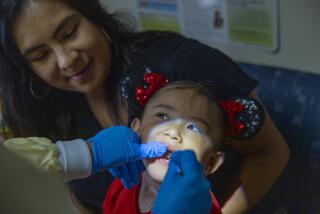Now’s the time to stop thumb sucking
- Share via
When my oldest daughter was an infant, she turned to a toy cat for comfort; for my younger two children, baby blankets did the trick. For many infants, however, the answer is much closer to home -- literally, right at the tip of their fingers. It’s their thumb.
Thumb sucking is a normal calming behavior during infancy; at one year of age, nearly 1 in 3 children suck their thumbs. Although many quit spontaneously before they turn 3, an estimated 20% of children continue well beyond this age.
Conventional wisdom has dictated that this type of prolonged habit causes dental problems only if it persists after the permanent teeth start to come in. New research suggests that may not be the case.
“The assumption has been that quitting by age 5 or 6 is acceptable,” says Mary Hayes, a pediatric dentist and spokeswoman for the American Dental Assn., “but we now know that we have to worry about it earlier.”
Los Angeles resident Mylene Moreno was surprised when her children’s dentist told her that her youngest son, Pablo, then 4, had to kick the habit. “We were basically given marching orders to get him to stop sucking his thumb,” recalls Moreno. “It seemed so drastic to me.”
In a study published in Pediatric Dentistry in 2005, John Warren, an associate professor in the College of Dentistry at the University of Iowa, and his colleagues followed several hundred children from infancy into early childhood and evaluated the effects of nonnutritive sucking behaviors, like thumb sucking, on the teeth and jaws.
They found that thumb sucking can push the front teeth forward, causing them to stick out too much in relation to the teeth in the lower jaw. It also can prevent the front teeth from coming together properly and can cause a misalignment of the upper and lower jaws.
Although these problems can often be corrected with braces, experts agree that it is better to stop them from developing. “The best course of action is to prevent thumb sucking from ever becoming a habit,” says Warren. “Even if that involves giving the child a pacifier.” Although pacifiers can cause dental problems, they tend to be less severe.
Warren recommends that children who start to suck their thumbs be encouraged to quit by age 3. Quitting can be difficult, but positive reinforcement can persuade many children to quit -- praising children when they are not sucking their thumbs is sometimes enough. Others may need a reminder, such as a bandage worn on the thumb, or a deterrent, such as a bitter solution applied to the finger.
When these techniques are unsuccessful, parents can resort to a dental appliance. The Bluegrass appliance consists of a small roller, secured behind the front teeth, that serves simply as a reminder that the thumb shouldn’t be in the mouth. This type of appliance can be very effective: A 2003 study found that it successfully eliminated thumb sucking in 28 of 30 people between the ages of 4 and 20; the average treatment time was just more than 12 weeks.
The need to quit, however, is not as pressing for some children as it is for others. “While they’re all at risk for developing problems, the risk does not manifest itself in everyone,” Hayes says. Some children may suck their thumbs for years and never develop a problem; others may develop one very early on. For that reason, it’s important to have a dentist evaluate children on a case-by-case basis.
As for Pablo, he recently turned 5 and is still sucking his thumb. Although his habit is clearly affecting his teeth, it seems to fulfill an important function for Pablo, and Moreno is reluctant to push him too hard to quit. “Whenever he’s unsure of himself, he sucks his thumb,” says Moreno. “It’s seems to be something that he just needs.”
Moreno hopes to find a way to balance her son’s emotional needs with his physical ones. Although she’s been avoiding going back to the dentist, she realizes that the time to get serious about quitting has come.
*
Dr. Valerie Ulene is a board-certified specialist in preventive medicine practicing in Los Angeles. She can be reached at themd@att.net. The MD appears the first Monday of the month.





